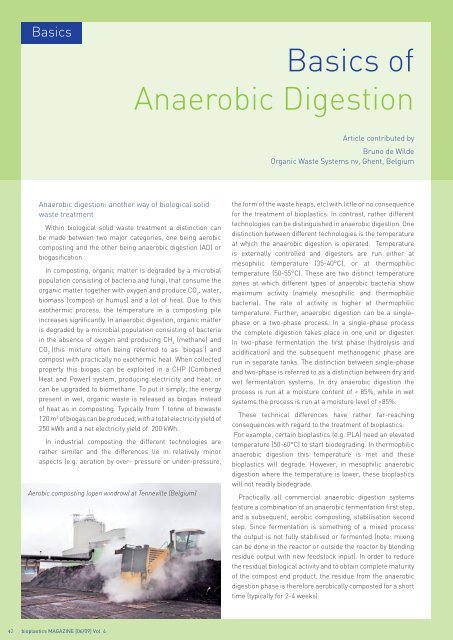bioplasticsMAGAZINE_0906
bioplasticsMAGAZINE_0906
bioplasticsMAGAZINE_0906
You also want an ePaper? Increase the reach of your titles
YUMPU automatically turns print PDFs into web optimized ePapers that Google loves.
Basics<br />
Basics of<br />
Anaerobic Digestion<br />
Article contributed by<br />
Bruno de Wilde<br />
Organic Waste Systems nv, Ghent, Belgium<br />
Anaerobic digestion: another way of biological solid<br />
waste treatment<br />
Within biological solid waste treatment a distinction can<br />
be made between two major categories, one being aerobic<br />
composting and the other being anaerobic digestion (AD) or<br />
biogasification .<br />
In composting, organic matter is degraded by a microbial<br />
population consisting of bacteria and fungi, that consume the<br />
organic matter together with oxygen and produce CO 2<br />
, water,<br />
biomass (compost or humus) and a lot of heat. Due to this<br />
exothermic process, the temperature in a composting pile<br />
increases significantly. In anaerobic digestion, organic matter<br />
is degraded by a microbial population consisting of bacteria<br />
in the absence of oxygen and producing CH 4<br />
(methane) and<br />
CO 2<br />
(this mixture often being referred to as ‘biogas‘) and<br />
compost with practically no exothermic heat. When collected<br />
properly this biogas can be exploited in a CHP (Combined<br />
Heat and Power) system, producing electricity and heat, or<br />
can be upgraded to biomethane. To put it simply, the energy<br />
present in wet, organic waste is released as biogas instead<br />
of heat as in composting. Typically from 1 tonne of biowaste<br />
120 m 3 of biogas can be produced, with a total electricity yield of<br />
250 kWh and a net electricity yield of 200 kWh.<br />
In industrial composting the different technologies are<br />
rather similar and the differences lie in relatively minor<br />
aspects (e.g. aeration by over- pressure or under-pressure,<br />
Aerobic composting (open windrow) at Tenneville (Belgium)<br />
the form of the waste heaps, etc) with little or no consequence<br />
for the treatment of bioplastics. In contrast, rather different<br />
technologies can be distinguished in anaerobic digestion. One<br />
distinction between different technologies is the temperature<br />
at which the anaerobic digestion is operated. Temperature<br />
is externally controlled and digesters are run either at<br />
mesophilic temperature (35-40°C), or at thermophilic<br />
temperature (50-55°C). These are two distinct temperature<br />
zones at which different types of anaerobic bacteria show<br />
maximum activity (namely mesophilic and thermophilic<br />
bacteria). The rate of activity is higher at thermophilic<br />
temperature. Further, anaerobic digestion can be a singlephase<br />
or a two-phase process. In a single-phase process<br />
the complete digestion takes place in one unit or digester.<br />
In two-phase fermentation the first phase (hydrolysis and<br />
acidification) and the subsequent methanogenic phase are<br />
run in separate tanks. The distinction between single-phase<br />
and two-phase is referred to as a distinction between dry and<br />
wet fermentation systems. In dry anaerobic digestion the<br />
process is run at a moisture content of < 85%, while in wet<br />
systems the process is run at a moisture level of >85%.<br />
These technical differences have rather far-reaching<br />
consequences with regard to the treatment of bioplastics.<br />
For example, certain bioplastics (e.g. PLA) need an elevated<br />
temperature (50-60°C) to start biodegrading. In thermophilic<br />
anaerobic digestion this temperature is met and these<br />
bioplastics will degrade. However, in mesophilic anaerobic<br />
digestion where the temperature is lower, these bioplastics<br />
will not readily biodegrade.<br />
Practically all commercial anaerobic digestion systems<br />
feature a combination of an anaerobic fermentation first step,<br />
and a subsequent, aerobic composting, stabilisation second<br />
step. Since fermentation is something of a mixed process<br />
the output is not fully stabilised or fermented (note: mixing<br />
can be done in the reactor or outside the reactor by blending<br />
residue output with new feedstock input). In order to reduce<br />
the residual biological activity and to obtain complete maturity<br />
of the compost end product, the residue from the anaerobic<br />
digestion phase is therefore aerobically composted for a short<br />
time (typically for 2-4 weeks).<br />
42 bioplastics MAGAZINE [06/09] Vol. 4


















